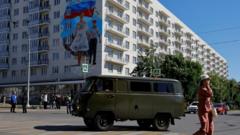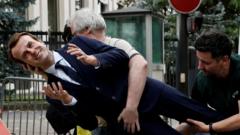In occupied cities like Melitopol, Mariupol, and Crimea, Ukrainians face harsh realities under Russian rule. While some engage in covert resistance through daily acts of defiance, others grapple with the pain of disrupted lives. Despite risks of persecution and fear, hope prevails among the people as they navigate their new reality.
Resilience Amidst Occupation: Stories of Silent Defiance in Ukraine

Resilience Amidst Occupation: Stories of Silent Defiance in Ukraine
As a fifth of Ukraine remains under Russian control, brave individuals share their acts of resistance against oppression.
In the heart of Ukraine, where Russian occupation has cast a long shadow, stories of quiet defiance emerge alongside the stark realities of life under tyranny. With nearly one-fifth of Ukrainian territory under Russian control, the future appears thin for those caught in its grasp. Recent conversations with three residents of occupied cities reveal the complexity of their circumstances, trepidations, and acts of resistance as they navigate an uncertain existence.
In Melitopol, Mavka stands resolutely against the oppressor, refusing to abandon her hometown. Since the invasion began on February 25, 2022, she has borne witness to a surge in "Russification" that permeates every aspect of life, culminating in militarized schooling that features Russian symbols and an environment that demands conformity. She recently shared images of a billboard promoting conscription and a disturbing scene of children donning military uniforms during class, pointing to the intense presence of authority.
Further along in Mariupol, Pavlo recounts a similarly grim reality. The key port city, ravaged during the siege of 2022, has now become a microcosm of suffering under Russian control. Mandatory Russian citizenship looms over the populace as a necessity for survival, ensnaring families with stringent demands. He reflects on the anxiety that permeates daily life—a child refusing to sing the Russian anthem leads to potential FSB scrutiny, suspending families in fear. Despite sustaining grave injuries during the siege, he remains tethered to Mariupol, hoping to support his ailing relatives amid a rising tide of unemployment and property destruction. Conversations amongst residents are dominated by concerns of lost homes and survival.
Meanwhile, Iryna carries the weight of grief over Crimea's eroding identity—a region that has been under occupation since 2014. She remains vigilant to protect her home and care for her elderly relative, constantly aware of the new rules that suppress acknowledgment of Ukrainian culture. Singing the Russian anthem at her child’s nursery school has become obligatory, and Iryna finds solace in wearing her traditional vyshyvanka during private moments, a gentle reminder of happier times lost.
Yet, alongside these lived experiences of anxiety and repression, flickers of courage and solidarity emerge. Mavka relates her involvement in Zla Mavka, a clandestine women's resistance movement. Through social media platforms, they clandestinely record life under occupation, punctuated by public displays of the Ukrainian spirit aimed at reminding others that hope remains. From placing symbols to distributing pamphlets, each endeavor carries risks that could endanger their lives, but they persevere, motivated by a firm belief in Ukrainian resilience.
Resistance also manifests in small acts of rebellion, such as sabotaging provisions meant for occupying soldiers, compounding the dangers that accompany their courage. Mavka expresses concerns regarding the potential erasure of their identity should the war end without a proper resolution. The fear of a ceasefire that entrenches Russian dominance looms large—a specter that compels the Ukrainian spirit, dependent on the world’s attention and solidarity.
While Iryna weeps for the loss of innocence she witnesses in her community, Pavlo contemplates the moral complexities of negotiating peace. Each protagonist reflects a nuanced understanding of living amid conflict—a fight for identity, home, and broader hope remains at the forefront of their daily lives.
As they wait and watch for change, the people of these occupied cities in Ukraine remain steadfast, forming networks of resilience even as the specter of oppression looms. Their silent acts of defiance symbolize a refusal to succumb to despair, illuminating the undying will of a nation yearning for freedom.
In Melitopol, Mavka stands resolutely against the oppressor, refusing to abandon her hometown. Since the invasion began on February 25, 2022, she has borne witness to a surge in "Russification" that permeates every aspect of life, culminating in militarized schooling that features Russian symbols and an environment that demands conformity. She recently shared images of a billboard promoting conscription and a disturbing scene of children donning military uniforms during class, pointing to the intense presence of authority.
Further along in Mariupol, Pavlo recounts a similarly grim reality. The key port city, ravaged during the siege of 2022, has now become a microcosm of suffering under Russian control. Mandatory Russian citizenship looms over the populace as a necessity for survival, ensnaring families with stringent demands. He reflects on the anxiety that permeates daily life—a child refusing to sing the Russian anthem leads to potential FSB scrutiny, suspending families in fear. Despite sustaining grave injuries during the siege, he remains tethered to Mariupol, hoping to support his ailing relatives amid a rising tide of unemployment and property destruction. Conversations amongst residents are dominated by concerns of lost homes and survival.
Meanwhile, Iryna carries the weight of grief over Crimea's eroding identity—a region that has been under occupation since 2014. She remains vigilant to protect her home and care for her elderly relative, constantly aware of the new rules that suppress acknowledgment of Ukrainian culture. Singing the Russian anthem at her child’s nursery school has become obligatory, and Iryna finds solace in wearing her traditional vyshyvanka during private moments, a gentle reminder of happier times lost.
Yet, alongside these lived experiences of anxiety and repression, flickers of courage and solidarity emerge. Mavka relates her involvement in Zla Mavka, a clandestine women's resistance movement. Through social media platforms, they clandestinely record life under occupation, punctuated by public displays of the Ukrainian spirit aimed at reminding others that hope remains. From placing symbols to distributing pamphlets, each endeavor carries risks that could endanger their lives, but they persevere, motivated by a firm belief in Ukrainian resilience.
Resistance also manifests in small acts of rebellion, such as sabotaging provisions meant for occupying soldiers, compounding the dangers that accompany their courage. Mavka expresses concerns regarding the potential erasure of their identity should the war end without a proper resolution. The fear of a ceasefire that entrenches Russian dominance looms large—a specter that compels the Ukrainian spirit, dependent on the world’s attention and solidarity.
While Iryna weeps for the loss of innocence she witnesses in her community, Pavlo contemplates the moral complexities of negotiating peace. Each protagonist reflects a nuanced understanding of living amid conflict—a fight for identity, home, and broader hope remains at the forefront of their daily lives.
As they wait and watch for change, the people of these occupied cities in Ukraine remain steadfast, forming networks of resilience even as the specter of oppression looms. Their silent acts of defiance symbolize a refusal to succumb to despair, illuminating the undying will of a nation yearning for freedom.



















